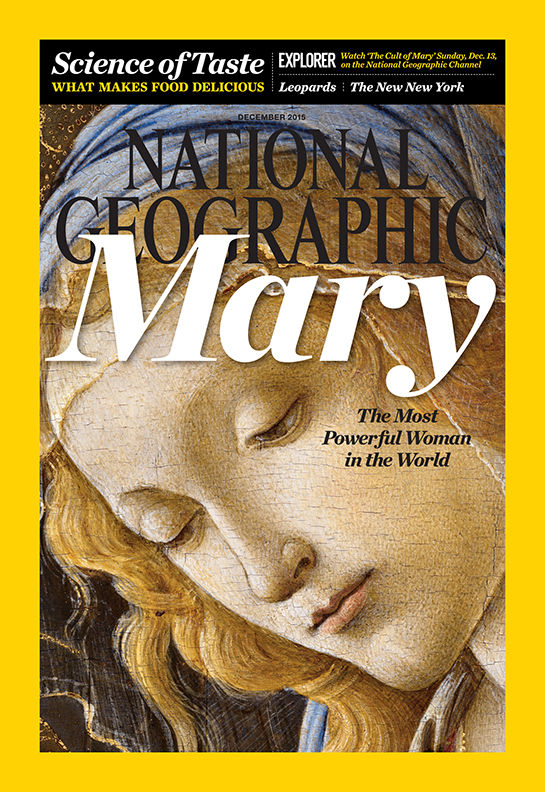It’s that time of year when the panoply of media scramble to qualify things with top 10 lists of movies or television shows, or lists of who is the most beautiful, who is the most influential and on and on.
To demonstrate how far back this need to pick cultural winners and losers goes, Time Magazine’s first “Man of the Year” was Charles Lindbergh. Now they call it “person” of the year and the current chancellor of Germany Angela Merkel won the cover of Time.
Usually I would place the same amount of importance toward what the editors of Time or People magazine or TMZ think about any given public figure as I would to what the Audubon Society thought was the most fragrant Siberian Dwarf Pine. That is until I saw the December issue of National Geographic magazine and the person they selected as the “Most Powerful Woman in the World.”
The Blessed Mother.
She did not run a country, never had a reality TV show on the E channel or made headlines at night spots with celebrity photographer headhunters on her trail. Yet, more than 2,000 years after the Annunciation, Mary remains topical.
So much so that she is referred to in the present tense in the National Geographic cover as “The Most Powerful Woman in the World.” She is not characterized as one of the most powerful women or once one of the most powerful women, but plainly as “THE” most powerful woman in the world — which she has been ever since that day when she uttered the eternal “yes” to counter-balance the “no” that her predecessor Eve had uttered in the Garden of Eden.
The article in National Geographic turns no new soil in regard to Mary and her place in Christian salvation history, though it does seem to betray a certain ignorance of Catholic teaching when it declares, “Mary is often the touchstone of our longing for meaning, a more accessible link to the supernatural than formal Church teachings.”
What is the Assumption and the Immaculate Conception other than formal Church teachings?
From my theological armchair, I do agree with the article’s premise that Mary is the great human conduit to the divine. And as the article further points out, though Mary’s appearances in the Gospels are brief, they are never superfluous. She is the great mediatrix for us all.
Her intervention at the wedding in Cana does so much more than merely demonstrate Mary’s power. By asking her Son to do something when the wine runs out, she is making the very first prayer in human history to the person of Jesus.
And despite getting a rather icy and pithy reply from her son at first, Mary is undeterred, instructs the servants to follow her son’s lead, and the rest is scriptural history.
Mary is the great gift we creatures were given. We cannot love Mary more than Jesus because we cannot love Mary as much as Jesus loved Mary, so I have no fear of falling into any sort of “Mary worship” trap some of our separated brethren may caution against.
Just as it has been incredibly difficult to successfully portray Jesus in film and television, Mary is likewise a hard literary topic to tackle. The image of a passive woman just does not ring true from what the Scriptures tell us about her. There is nothing passive about dialoguing with a supernatural messenger of God to discuss whether or not yxou will take on the role of the Theotokos. Not exactly a role for a shrinking violet.
Traveling to a relatively distant town while near the end of your pregnancy, almost immediately having to flee your homeland after giving birth, and then experiencing the three intense years of Jesus’ public ministry, death and resurrection are also not for the faint of heart.
There is a map in the National Geographic article — there are always maps in National Geographic articles — depicting the more than 2,000 locations where there have been reported sightings of the Blessed Mother, but only 16 are officially recognized by the Church, demonstrating the importance the Church places on Marian devotion and stipulating how the Church teaches Mary’s continuing presence in our spiritual and earthly lives.
Saint Pope John Paul II was utterly convinced his life was spared from an assassin’s bullet by the Blessed Mother. The near fatal bullet, which was fired at him on the Feast of Our Lady of Fatima, was successfully removed from his body and now rests in the crown of the statue of the Blessed Mother in the Basilica in Fatima. Even an agnostic has to believe that is not mere coincidence.
So fitting that a magazine which covers the globe recognizes Mary as the most powerful woman of the world. She is a gift that relates to every level of human experience.
She gave birth out in the open in the elements which puts her on par with the poorest of the poor. Her marriage to her craftsman husband makes that part of her life within the Holy Family before Jesus’ public ministry, relatively middle class.
And her assumption into Heaven and eventual coronation as the Queen of Heaven makes her as influential and as powerful as any blue-blooded man or woman who ever inherited, usurped or longed for a throne of earthly power.
What an exclamation point to the conclusion of Advent that the one human most responsible for the incarnation should be so recognized now. Amazing what can be achieved with a simple yes.

